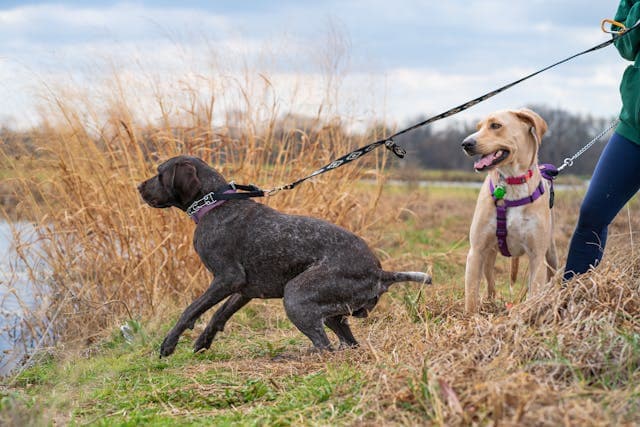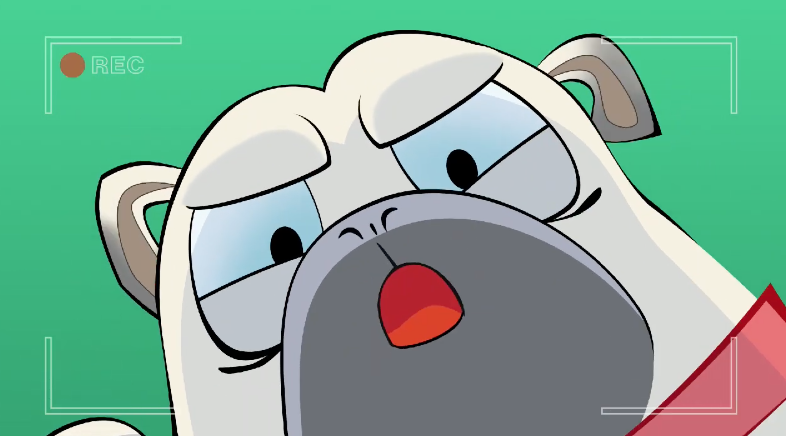

13 Common Dog Behavioral Problems and Practical Tips on Fixing Them
Whether your dog is one of your children or your best friend, they’re definitely part of the family. And just like our human families, dogs have reactions to seasons, major life changes, new routines, and even getting older. Their mental health and the environment they’re in can have major effects on their behavior. Some behavioral conditions can come from medical issues while others from miscommunication with their owners. With these tips, though, you can figure out what’s going on with your pup and how to lovingly work through misbehavior.

Writer Jannah Berkley
11 min read

1. Barking
There’s a normal amount of barking and then there’s the excessive kind (you know, when your whole block badmouths you). The main reasons dogs whine or bark are because they’re trying to send a warning, they’re very excited, they want attention, they have anxiety, they’re bored or they’re chatting with other dogs.
How you can help
Well, you can train them to follow “quiet” commands for times you’re home. What that means is waiting for intervals between barks, and then rewarding them with snacks. You can further drive the point home that you’re treating them for not barking by saying “yes” or using a clicker. If the excessive barking happens a lot while you’re away, meanwhile, your pup may need more stimulation or time outside the house.
2. Chewing
Chewing is another natural thing that dogs love to do. But when they’re no longer puppies and they eat your shoes, your couch, your pillows… something else may be going on. Puppies do this a lot because of curiosity and because they’re teething and it relieves their discomfort. Adult dogs, though, may have been inside for too long, feel bored, or have anxiety.
How you can help
Make sure they have chew toys that they love and get them excited. They’re more likely to play independently with chew toys or a (safe!) bone if you play with it a bit first. Also, it’s always a good idea to put your precious items away while you’re not home to limit the amount of damage they can potentially do. Sometimes dogs don’t know any better and they don’t always mean to destroy your favorite socks, they were just there!
3. Destructive digging
Certain dog breeds are just born to dig. Terriers, Dachshunds, Beagles, Schnauzers, Huskies, Malamutes, and Australian Shepherds, to name a few, are especially prone to this behavior. Digging is fun for most breeds of dogs, but if your dog is turning your backyard into a prehistoric crater field, they may need some help to stop. If the excavation is carried out near trees, they may be hunting burrowing animals. If they’re digging large holes and sitting in them, they may be seeking protection or comfort from extreme temperatures or rain. If they’re digging by a fence, they may be trying to escape. They may also need more attention or stimulation.
How you can help
You can line your property with large rocks along the bottom of the fence to keep your dog safely on your property. And for their entertainment, you can create a designated digging spot like a sandbox. If you bury bones and turn that spot into a game, you can focus their energy there.
4. Separation anxiety
Does your dog get very clingy, nervous or start acting out right before you leave the house? They may be suffering from separation anxiety. If your schedule – or theirs – has recently changed, new visitors, new family members, or you’ve moved recently, this behavior often pops up. Luckily, mild separation anxiety is very frequently fixed from proper training.
How you can help
One technique you can try is leaving your dog a puzzle toy with their favorite treat inside. This way they begin to associate your leaving with their favorite food. If their anxiety gets very bad, self-destructive or they can’t control going potty, there are also medications that your vet can recommend to calm them down. Before you do, though, consult a trainer, who’ll help you differentiate between actual separation anxiety and boredom or a surplus of unexpended energy. Chewing up your socks doesn’t mean anxiety – real anxiety manifests in things like dogs licking or scratching themselves bloody or injuring themselves by trying to dig in the floor or under a door.
5. Begging for food
Most dog owners don’t realize that they’ve inadvertently taught their pets that begging is a good way to get yummy bites. Even if you give your dog table scraps just once, they may learn to expect this.
How you can help
The best way to avoid this is to never feed them from the table, period. Make sure they go to their area before mealtime. If you’re going to give them food scraps, bring it to their bowl and make them sit before they get to enjoy it. This way they understand the boundaries of special food.
6. Doing their business indoors
Obviously when you’re training a puppy or a rescue dog, there’s a good chance they’re going to have accidents. But pooping and peeing indoors can also be a sign of other issues. Your pup may feel a need to mark their territory because of another pet at home, or an aggressive neighbor. They also might be feeling anxious or lonely.
How you can help
You can create a dog door so they have access to go in and out on their own, even if you’re not home. Or you could train your dog to use a doggy door bell when they need to use the bathroom or want to go outside. Yeah, that’s a thing. And if the problem persists, you should strongly consider consulting a vet, as the underlying cause may be a medical issue rather than a behavioral one.
7. Jumping up
This is a totally natural reaction of excitement and joy for most dogs. But the fact of the matter is that not all people – like your grandma, probably – like to be jumped on.
How you can help
If you’re trying to get your dog to stop jumping up on you, the easiest way to get them to stop is to completely ignore them. If you avoid looking at them and giving them attention for it, they’ll most likely lose interest and stop. If you’re trying to get them to stop jumping on people as they enter the house or strangers in public spaces, you can ask that they also ignore your dog and calmly walk away. Once your dog calms down, rewarding them with a treat will reinforce their calm, grounded behavior.
8. Leash pulling
There’s nothing a dog loves more than a walk, but when they pull aggressively it can completely change the mood. Dogs are so excited by new smells and creatures, so the only way to quell that urge to run towards the stimuli is to train them properly.
How you can help
Reward your pup for great walks and whenever they start to pull, stop the walk. If you continue to walk as they pull, they feel the behavior is acceptable. Wait for a loose leash until you start to walk again. Also, try and keep a consistent pace. If you suddenly slow down to text or chat with someone, your dog will most likely pull to try and keep that original pace. If the pulling problem is seriously aggravated, consult a dog trainer, who’ll help you decide which method to use – and how to properly use it. Also, make sure your dog is wearing a collar or leash that’s right for them – some dogs vibe with one type way more than the other.

9. Aggression
Does your dog growl, show their teeth or chomp? These are all signs of aggression that may be caused by a handful of things. If your dog is from a shelter or has a history of abuse, this may be the only way they learned how to protect themselves. Even dogs who’ve had a sweet, loving home for their whole entire lives have the potential to get aggressive. It’s in their animal nature. That being said, aggression may also be a byproduct of fear – dogs react differently to stress or being scared. Some freeze up, some flee – and some attack.
How you can help
With aggression, home training or expert training are the main way, but it’s never 100%. So it’s always good to have a strong short leash with you for unexpected aggression. If being aggressive is out of character for your dog, they may be in pain or not feeling well. So if they suddenly and uncharacteristically become aggressive, take them to the vet for a checkup to make sure nothing’s wrong.
10. Biting/nipping
This is a natural instinct for dogs and when they’re puppies, this is how they explore their new world. Adult dogs would teach their puppies to stop nipping, but most dog owners don’t have their puppy’s mom around to teach them stuff. So it’s on us to train them not to do this. As they get older, they may continue to bite because they sense danger, out of defense, or out of a desire to protect you. Even in some situations that don’t feel threatening at all to you, dogs might feel, smell or hear something you can’t sense.
How you can help
Make sure your dog is socializing well – and from a young age, if possible – with other dogs, adults, and children and trained to stop nipping. And like we said in the previous section, if your pup isn’t a biter normally and they suddenly start chomping, take them to a vet to make sure nothing medical made them behave that way.
11. Herding/chasing
As is the case with digging, some dog breeds are born to herd: Australian Cattle Dogs, Australian Shepherds, Sheepdogs, and Collies to name just a few. It’s in their nature and they’ll always do this more than some other breeds. If your dog is trying to play by chasing other dogs, this is totally normal behavior. But if they’re chasing cars or being aggressive, you’ll need to step in to keep everyone safe.
How you can help
To get your pup to stop chasing cars, you can use the distract and reward technique by giving them a treat when they don’t go after the car. If they’re chasing other dogs, make sure you have a whistle on you that they know to respond to when you blow it.
12. Compulsive behaviors
These behaviors include incessant licking, pacing, circling, barking in a certain repetitive pattern, and any other kind of self mutilation. Some of these things are typical of many dogs in normal quantities, but if you notice any of them at an excessive level, they could be signs of a compulsive disorder.
How you can help
First, check with your vet to make sure to rule out any neurological diseases. Creating consistent and predictable routines can also help calm compulsive behaviors. Also consider making sure your dog has access to a calm, quiet place at any time, whether or not you’re home.
13. Anxiety
Dogs can be anxious from birth or they can develop anxiety over the course of their lifetime. They can begin to feel anxious from separation, fear, new routines, and even aging. Yeah, dogs feel it too. Some common symptoms of anxiety include drooling, panting, urinating indoors, pacing, destructive behavior, and excessive barking. Some senior dogs might also get anxious when they begin developing cognitive dysfunction syndrome (CDS).
How you can help
The best starting point is to talk to your vet and come up with a combination of training, situational changes, and maybe medication in severe cases. And like we said in the section for separation anxiety, it’s important to have perspective on what is – and isn’t – true anxiety. Make sure to learn the difference between a bored dog with too much energy, and a dog with a serious behavioral issue.
One last time for the folks in the back – keep in mind that all of these behaviors may be caused by an underlying medical condition. If nothing at home is working to change the behavior, it may be a good time to see your vet. And if your dog doesn’t have any health problems, expert training is always a good idea!
Just in case one of these problem behaviors is caused by an underlying medical condition, make sure your dog enjoys the safety of Animalia Pet Insurance’s coverage. It could be the difference between getting them cheap care – and the care they deserve.





We offer the most
comprehensive coverage
out there
car with a spare tire for life’s bumps.
Having Animalia is like a pimped-out
Rolls Royce with a swimming pool
in the trunk.



Get your pet insurance quote
Pet type
- Dog
- Cat
What is your pet's name?
Zip code






